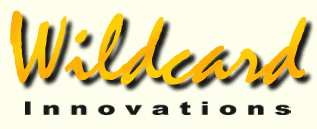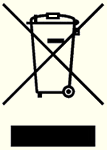

Following international agreement on the basic principles of protecting the environment from hazardous substances released by Electrical and Electronic Equipment at the end of its life, the European Parliament introduced Directives calling for all member states to pass legislation to ban certain substances (such as lead) from the manufacture of electronic products and to mandate recycling at the end of their useful life.
The directive calling for the safe disposal and/or recycling of Waste Electrical and Electronic Equipment at the end of its life is generally referred to as the WEEE directive. This legislation is being introduced in a phased way with significant differences still evident between EU Member states.
 You will find this wheely bin symbol is attached to some of our products
or is included on literature associated with some of our products.
This symbol indicates that this product is not to be disposed of with
your household waste, according to the WEEE Directive (2002/96/EC) and
your national law.
You will find this wheely bin symbol is attached to some of our products
or is included on literature associated with some of our products.
This symbol indicates that this product is not to be disposed of with
your household waste, according to the WEEE Directive (2002/96/EC) and
your national law.
At the end of their life, products marked as such should be handed over to a designated collection point, e.g., an authorized collection site for recycling waste electrical and electronic equipment (EEE). Improper handling of this type of waste could have a possible negative impact on the environment and human health due to potentially hazardous substances that are generally associated with EEE. At the same time, your cooperation in the correct disposal of this product will contribute to the effective usage of natural resources. For more information about where you can drop off your waste equipment for recycling, please contact your local city office, waste authority, approved WEEE scheme or your household waste disposal service.
The directive which bans substances from the manufacturing process is generally referred to as RoHS (Reduction of Hazardous Substances) and it came into full force within the EU in July 2006.
Our policy is that all products we manufacture are compliant with the RoHS directive.
RoHS compliance requires our products to be virtually free of all of the so-called hazardous substances on the banned list. To achieve this we have invested in a lead-free Printed Circuit Board (PCB) assembly capability and are sourcing all of the electronic components used on the PCBs to be also free of hazardous substances that are on the banned list. For example, rather than use solders made from an alloy of tin-lead, our advanced manufacturing process uses solders based on alloys of tin-silver-copper. As part of this advanced process, our PCBs currently utilize state-of-the art laminates and finishes of nickel and gold to ensure the highest levels of quality and reliability.
Though the RoHS directive is only applicable to EU member states, our policy is to employ world's best environmental practice and in that regard we export RoHS compliant product to all countries in the world, even if those countries are yet to ban substances that appear on the RoHS hazardous list.